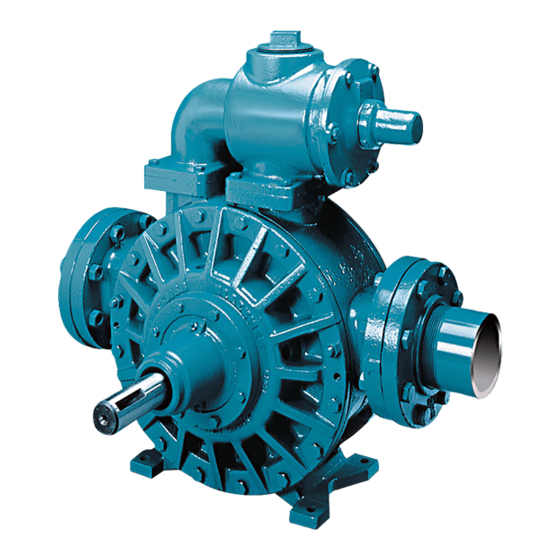Dover PSG BLACKMER MRLX4B Instruções de instalação, operação e manutenção - Página 4
Procurar online ou descarregar pdf Instruções de instalação, operação e manutenção para Bomba de água Dover PSG BLACKMER MRLX4B. Dover PSG BLACKMER MRLX4B 20 páginas. Power pumps

COUPLING ALIGNMENT
The pump must be directly coupled to a gear and/or driver
with a flexible coupling. Verify coupling alignment after
installation of new or rebuilt pumps. Both angular and
parallel coupling alignment MUST be maintained between the
pump, gear, motor, etc. in accordance with manufacturer's
instructions. See Figure 3.
1.
Parallel alignment: The use of a laser alignment tool or
dial indicator is preferred. If a laser alignment tool or dial
indicator is not available, use a straightedge. Turn both
shafts by hand, checking the reading through one
complete revolution. Maximum offset must be less than
.005" (125 microns).
2.
Angular alignment: Insert a feeler gauge between the
coupling halves. Check the spacing at 90° increments
around the coupling (four checkpoints). Maximum
variation must not exceed .005" (125 microns). Some
laser alignment tools will check angular alignment as
well.
3.
Replace the coupling guards after setting alignment.
Figure 3 – Alignment Check
Operation without guards in place can
cause serious personal injury, major
property damage, or death.
Do not operate
without guard
in place
PUMP ROTATION
A right-hand pump rotates clockwise with the intake on the
right side, when viewed from the driven end.
A left-hand pump rotates counterclockwise with the intake on the
left side, when viewed from the driven end.
TO REVERSE PUMP ROTATION
ML4B Series pumps have double-ended shafts, allowing the
pump to be driven from either end. Rotation is changed by
reversing the position of the pump assembly. To do so, rotate
the pump 180 degrees so that the opposite shaft becomes
the driven shaft.
INSTALLATION
CHECK VALVES
The use of check valves or foot valves in the supply tank is
not recommended with self-priming, positive displacement
pumps.
If the possibility of liquid backflow exists when the pump is
off, a check valve in the pump discharge piping is
recommended because the pump can motor in the reverse
rotation and create undue stress on all attached components.
Never start a pump when it is rotating in the reverse rotation
as the added starting torque can damage the pump and
related equipment.
OPTIONAL JACKETED HEADS
Hot oil or steam can be circulated through jacketed heads by
connections at the ½" NPT pipe plugs directly above and
below the shaft for heating highly viscous liquids, or to "thaw
out" liquids which have congealed in the pumping chamber
and packing area. Maximum recommended steam pressure
is 150 psi (10.3 bar).
Make sure heat is applied early enough to sufficiently thin the
liquid before starting the pump. Liquids that congeal in the
relief valve chamber will make the valve inoperative.
Insulation of the pump with sufficient heat to the jackets will
usually thin the liquid in the relief valve chamber. Take
precautions to ensure the valve has free movement. It is
advisable to start the pump with an open discharge.
MANUAL BYPASS VALVE
Excessive discharge pressure can result in damage to
the pump or personal injury. In order to control system
pressure, a bypass valve or other pressure limiting
device must be installed in the discharge pumping
system.
A bypass line from the pump discharge to the pump suction,
with a manual shut-off valve, is recommended when handling
volatile liquids, viscous liquids at a high lift, or when delivering
to piping too small to take the full flow from the pump. For
example:
1.
When handling very viscous liquids, excessive pressure
may develop when starting the pump. To avoid possible
damage to the pump, open the bypass valve before
starting. After the pressure stabilizes and the pump is
running smoothly, close the valve slowly.
2.
When liquids are pumped under a high suction lift,
cavitation may result, causing the pump to become very
noisy and begin vibrating. By cracking the manual
bypass valve open, and permitting some of the liquid to
recirculate, the noise and vibration can be reduced to an
acceptable level. See other causes of noise and
vibration in the "General Pump Troubleshooting"
Section.
NOTE: With a 4" size pump, a 2" manual bypass valve and
recirculation line is recommended.
106-A00
Page 4/20
WARNING
